8-31-09 - Sunspot finally showed up.
|
NEW SUNSPOT:
A new sunspot is emerging about 15o
north of the sun's equator:
map. Pete Lawrence sends this picture from his backyard
observatory in Selsey, UK:

"It is small, but a welcome sight, especially after the
current long run of no surface activity," he says.
Indeed, if this active region consolidates into a true
dark-cored sunspot, it will break a string of nearly 52 spotless
days, one of the longest quiet spells of the current solar
minimum. Readers with
solar telescopes are encouraged to monitor developments. |
|
VANISHING RINGS: On Sept. 4, 2009, Saturn will
turn its rings edge-on to Earth, and for the first time in 14
years they will seem to disappear. "To mark the occasion I've made
an animation combining six years of Saturn observations," says New
York amateur astronomer Alan Friedman. "It shows the changing
plane of the ring system as viewed from my Buffalo backyard from
2004 to 2009.""The final frame is constructed from
observations I made earlier this year," he explains. "it shows how
the planet will appear on Sept. 4th."
Unfortunately, the actual ring plane crossing on Sept. 4th
will be practically impossible to observe. "On that day, Saturn
will be very close to the sun--only 11o away--and the
glare will hide the big event. In the fall of 2009, Saturn will
emerge from the glare of the sun in the early morning sky and
provide Earth-bound astronomers with our first glimpse of its
blue north pole in 14 years." |
|

A solar wind stream flowing
from the indicated coronal hole
could reach Earth on or about
Sept. 3rd.
Credit: SOHO Extreme UV Telescope
Current conditions
Solar wind
speed: 401.5 km/sec
density: 1.1 protons/cm3
explanation |
more data
Updated: Today at 0315 UT
X-ray Solar Flares
6-hr max: A0 2355 UT
Aug31
24-hr: A0 0030 UT
Aug31
explanation |
more data
Updated: Today at: 2355 UT
|
8-30-09 - No sunspots today
Current conditions
Solar wind
speed: 450.6 km/sec
density: 1.3 protons/cm3
explanation |
more data
Updated: Today at 2306 UT
X-ray Solar Flares
6-hr max: A0 2305 UT
Aug30
24-hr: A0 0915 UT
Aug30
explanation |
more data
Updated: Today at: 2305 UT
SOLAR SURPRISE:
Even during the deepest solar minimum
in a century, the sun has the capacity for surprise. Larry
Alvarez got one yesterday when he bent over the eyepiece of
his solar telescope in Flower Mound, Texas. "I thought it
would be just another day with a vanilla-wafer solar disk, but
I was in for a blazing shock when I checked out the edge of
the sun," he says. "There was a huge worm popping out of the
apple--a prominence of magnificent proportions!" Here is what
he saw:

View a video of the prom in action!
"What a doozy," he says. "I watched the prominence
for more than two hours and captured many good
images." The
video he made is a must-see (DivX
required).
Realtime images from the Solar and Heliospheric
Observatory indicate that the prominence remains
active. Readers with
solar telescopes should take a look. It's no
longer a surprise, but still a doozy.
images:
from Michael Borman of Evansville, Indiana;
from Matt Wastell of Brisbane, Australia;
from Pavol Rapavy of Observatory Romavska Sobota,
Slovakia;
from Mark Townley of Brierley Hill, West Midlands,
UK;
from Stephen Ames of Hodgenville, KY;
from Fabio Mariuzza of Biauzzo-Codroipo, Italy;
from Cai-Uso Wohler of Bispingen, Germany;
from Emiel Veldhuis of Zwolle, the Netherlands;
from Francisco A. Rodriguez of Cabreja Mountain
Observatory, Vega de San Mateo, Gran Canaria, Canary
Islands;
from Gianfranco Meregalli of Milano, Italy;

This photos is from LASCO images
http://sohowww.nascom.nasa.gov/data/realtime/realtime-c2.html |
8-29-09 - No sunspots today
Current conditions
Solar wind
speed: 358.3 km/sec
density: 2.2 protons/cm3
explanation |
more
data
Updated: Today at
2344 UT
X-ray Solar Flares
6-hr max: A0
2340 UT Aug29
24-hr: A0
0320 UT Aug29
explanation |
more
data
Updated: Today at:
2340 UT
ARCTIC AURORAS: There
are some places on Earth where all you have to
do to see the Northern Lights is ... to want
to. The Inuit village of Salluit in Nunavik,
Canada, is such a place. On most clear nights
at least a hint of auroras--and often much
more than a hint--can be found in the
sparkling midnight sky. Salluit resident
Sylvain Serre took this picture on August
27th:

"With a clear sky and very good weather, I
decided to go outside and take some pictures
of the Northern Lights--and there they were,"
he says.
Salluit is located under Earth's persistent
auroral oval, a luminous ring
circumscribing the north magnetic pole. Our
planet's magnetic field guides particles from
space into the oval and voila!--Northern
Lights. No geomagnetic storm is required.
August 2009 Aurora Gallery
[previous Augusts:
2008,
2007,
2006,
2005,
2004,
2003,
2002,
2001]
|
8-28-09 - No sunspots today
Current conditions
Solar wind
speed: 320.7 km/sec
density: 0.8 protons/cm3
explanation |
more
data
Updated: Today at
2344 UT
X-ray Solar Flares
6-hr max: A0
2340 UT Aug28
24-hr: A0
2340 UT Aug28
explanation |
more
data
Updated: Today at:
2340 UT
|
8-27-09 - No sunspots today
Current conditions
Solar wind
speed: 381.8 km/sec
density: 3.8 protons/cm3
explanation |
more
data
Updated: Today at
2344 UT
X-ray Solar Flares
6-hr max: A0
2340 UT Aug27
24-hr: A0
2340 UT Aug27
explanation |
more
data
Updated: Today at:
2340 UT
LUNAR OCCULTATION: On
Thursday, Aug. 27th, the half Moon will pass
directly in front of first-magnitude star
Antares. The event is best seen from the
Atlantic side of North America. Small
telescopes pointed at the Moon will show
Antares vanish behind the Moon's dark limb
around 4:30 pm EDT, all framed by afternoon
blue sky. [time
tables]
SOLAR ACTIVITY:
In the pits of a century-level solar minimum,
the sun is setting new records for quiet. But
really, how quiet can a 1027-ton
nuclear explosion (a star) ever be? The Solar
and Heliospheric Observatory recorded some
lively action on August 25th and 26th:

The 42-hour time-lapse movie
shows a prominence, a swirling cloud of
hydrogen held up unsteadily by solar magnetic
fields. Prominences appear to be the one form
of solar activity that continues apace even
when sunspots are absent. Readers with
solar telescopes, for a good show train
your optics on the edge of the sun.
more images:
from Joe Bartolick of Livermore,
California;
from Michael Buxton of Ocean Beach,
California;
from Adrian Guzman of San Jose, CA;
from Richard Bailey of Barham, Kent, UK;
from Monty Leventhal of Sydney. Australia;
from Stephen Ames of Hodgenville,
Kentucky;
from Pavol Rapavy of Observatory Rimavska
Sobota, Slovakia;
from Fabio Mariuzza of Biauzzo, Codroipo,
Italy
|
8-26-09 - No sunspots today
Current conditions
Solar wind
speed: 367.3 km/sec
density: 1.6 protons/cm3
explanation |
more
data
Updated: Today at
2344 UT
X-ray Solar Flares
6-hr max: A0
2340 UT Aug26
24-hr: A0
2340 UT Aug26
explanation |
more
data
Updated: Today at:
2340 UT
|
8-25-09 - No sunspots today
Current conditions
Solar wind
speed: 354.2 km/sec
density: 1.2 protons/cm3
explanation |
more
data
Updated: Today at
1342 UT
X-ray Solar Flares
6-hr max: A0
1340 UT Aug25
24-hr: A0
1340 UT Aug25
explanation |
more
data
Updated: Today at:
1340 UT
ETERNAL
DARKNESS: For years, planetary
scientists have speculated about places on the
Moon where the sun never shines. NASA may have
just found one of them. Behold the inky depths
of Crater Erlanger:

NASA's Lunar Reconnaissance Orbiter (LRO)
flew over the 10-km crater last week and took
a look inside. It was pure shadow. Crater
Erlanger is near the Moon's north pole.
Because the Moon's spin axis is tilted only
1.5 degrees, sunlight cannot surmount the
crater's steep rim to flood the interior.
What lies inside the darkness? An exciting
possibility is frozen water. Temperatures in
the dark bottom could be as low as -370
Fahrenheit, cold enough to keep ice from
sublimating even in hard lunar vacuum. Ice in
dark craters could be an invaluable resource
for future human explorers. Just melt and
drink. Or split H2O into hydrogen
for rocket fuel and oxygen for breathing.
Water also makes an excellent radiation
shield. Two spacecraft, the LRO and India's
Chandrayaan-1 probe, are pinging the crater
using onboard radars to learn more about
Erlanger's hidden deposits. Get the
full story from Arizona State University.
|
| 8-24-09 - No sunspots today
WHO NEEDS THEM?
Not all forms of solar activity require
sunspots. Throughout the weekend, amateur astronomers
monitored a huge prominence surging along the sun's
northeastern limb. This morning it erupted:
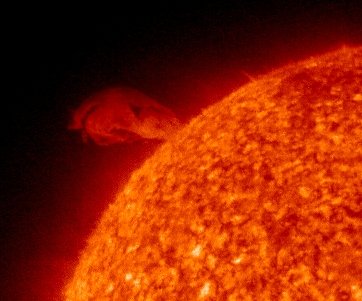
Prominences are clouds of red-hot hydrogen held above
the sun's surface by solar magnetic fields. Sometimes
those fields become unstable and erupt, hurling the cloud
into space. Such was the case today, Aug. 24th. The Solar
and Heliospheric Observatory recorded the action from
beginning to end in a 36-hour
time-lapse movie.
During the maximum phase of the solar cycle, an
eruption like this might be lost in the hubbub of
sunspots, solar flares, and geomagnetic storms. But
now....? Deep solar minimum does have its advantages.
Current conditions
Solar wind
speed: 359.6 km/sec
density: 2.3 protons/cm3
explanation |
more
data
Updated: Today at
2345 UT
X-ray Solar Flares
6-hr max: A0
2340 UT Aug24
24-hr: A0
2340 UT Aug24
explanation |
more
data
Updated: Today at:
2340 UT
|
|
8-23-09 - No sunspots today
Current conditions
Solar wind
speed: 422.6 km/sec
density: 2.2 protons/cm3
explanation |
more
data
Updated: Today at
2345 UT
X-ray Solar Flares
6-hr max: A0
2340 UT Aug23
24-hr: A0
0335 UT Aug23
explanation |
more
data
Updated: Today at:
2340 UT
|
| 8-22-09

Hodgenville,
KY
Details:A large set of
complex proms spanning almost 1/4 of the limb is gracing the
NW limb. A very clear loop part of the group...
HUGE
PROMINENCE: A solar prominence
big enough to swallow ten planet Earths is dancing
along the northeastern limb of the sun today. Readers
with
solar telescopes should take a look.
images:
from Les Cowley of the United Kingdom;
from Cai-Uso Wohler of Bispingen, Germany;
from Stephen Ames of Hodgenville, Kentucky
ARE
SUNSPOTS DISAPPEARING? Sunspots
are made of magnetism. The "firmament" of a sunspot is
not matter but rather a strong magnetic field that
appears dark because it blocks the upflow of heat from
the sun's fiery depths. Without magnetism, there would
be no sunspots.
That's what makes the following graph a little
troubling:
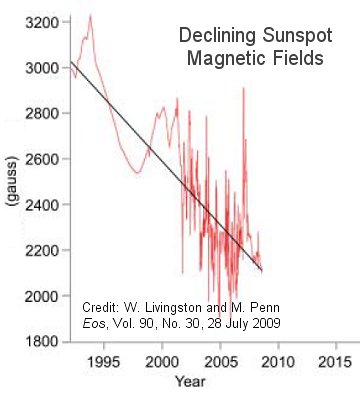
According to Bill Livingston and Matt Penn of the
National Solar Observatory in Tucson, Arizona, sunspot
magnetic fields are waning. The two respected solar
astronomers have been measuring solar magnetism since
1992. Their technique is based on
Zeeman splitting of
infrared
spectral lines emitted by iron atoms in the
vicinity of sunspots. Extrapolating their data into
the future suggests that sunspots could completely
disappear within decades. That would be a bummer for
Spaceweather.com.
Don't count out sunspots just yet, however. While
the data of Livingston and Penn are widely thought to
be correct, far-reaching extrapolations may be
premature. This type of measurement is relatively new,
and the data reaches back less than 17 years. "Whether
this is an omen of long-term sunspot decline,
analogous to the Maunder Minimum, remains to be seen,"
they caution in a
recent EOS article.
One thing is certain. Solar Minimum is a lot more
interesting than it sounds:
more.
Current conditions
Solar wind
speed: 508.7 km/sec
density: 2.0 protons/cm3
explanation |
more data
Updated: Today at 2345 UT
X-ray Solar
Flares
6-hr max: A0
2340 UT
Aug22
24-hr: A0
0025 UT
Aug22
explanation |
more data
Updated: Today at: 2340 UT
|
8-21-09 -
QUIET SUN:
According to NOAA sunspot counts, the longest stretch of
spotless suns during the current solar minimum was 52 days
in July, August and Sept. of 2008. The current spate of
blank suns is putting that record in jeopardy. There have
been no sunspots for almost 42 days and there are none in
the offing. Deep solar minimum continues.
Current
conditions
Solar wind
speed: 476.5 km/sec
density: 1.8 protons/cm3
explanation |
more data
Updated: Today at 2340 UT
X-ray Solar
Flares
6-hr max: A0
2340 UT
Aug21
24-hr: A0
0745 UT
Aug21
explanation |
more data
Updated: Today at: 2340 UT
FLYING
ISLANDS:
On August 14th, gravity was
revoked in the Netherlands--or
so it seemed when photographer
Rik ter Horst looked out
across the water and saw
Schiermonnikoog Island
floating in mid-air:

"It was just a mirage," he
says. Temperature gradients in
the air over the cool, open
water caused light from the
island and its surroundings to
curve in unusual ways en route
to the camera. The apparent
gap between the island and the
sea is actually an upside-down
image of the sky above. Note
the hint of antenna pointing
into the water. But don't look
too closely, cautions Horst.
"You might start believing
islands can fly."
more images:
from Peter von Bagh of
Porvoo, Finland;
from Mila Zinkova of San
Francisco, California;
from Ivar Marthinusen of
Storlien, Sweden;
from Becky Ramotowski of
Amarillo, Texas
|
8-20-09 -
BLANK SUN:
The sun is entering its 41st consecutive day without
sunspots. This remarkable string of blank suns shows that
we are still in the pits of the deepest solar minimum in a
century. If the streak continues for 11 more days, it will
match the longest blank spell of the current cycle.
Current
conditions
Solar wind
speed: 517.4 km/sec (This is the
highest wind speed this year)
density: 1.4 protons/cm3
explanation |
more data
Updated: Today at 2347 UT
X-ray Solar
Flares
6-hr max: A0
2345 UT
Aug20
24-hr: A0
2345 UT
Aug20
explanation |
more data
Updated: Today at: 2345 UT
|
8-19-09 No sunspots today - 39 days without a sunspot
Current conditions
Solar wind
speed: 431.6 km/sec
density: 9.3 protons/cm3
explanation |
more data
Updated: Today at 2146 UT
X-ray Solar Flares
6-hr max: A0 2140 UT
Aug19
24-hr: A0 2140 UT
Aug19
explanation |
more data
Updated: Today at: 2140 UT

The sun lives!
More out of hope than expectation I took an H-alpha look at
the sun with my Solarmax60 this afternoon, usually a time of
poor seeing. Remarkably the image was steady and this complex
prominence was evolving on the NW limb. Eyepiece sketch at
50X.
JUPITER MOON
MOVIE: Four hundred years ago when
Galileo
discovered the moons of Jupiter, the satellites appeared
in his primitive telescope as tiny, almost infinitesimal
specks of light pirouetting around the giant planet. Their
discovery transformed 17th century cosmology and made Galileo
famous, but he never saw them as anything more than star-like
pinpricks. The "Galilean satellites" were second-class
citizens in the heirarchy of known worlds. What would
Galileo say now?
On August 16th, Philippine astrophotographer
Christopher Go used a
modern
11-inch Celestron telescope to photograph Io casting its
shadow on Ganymede. Click on the image to launch the movie:
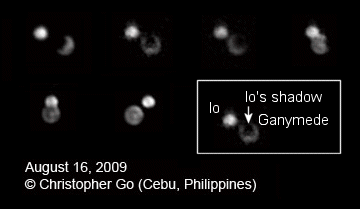
"I captured this rare event through a hole in the clouds,"
says Go. "It was a lucky clearing!"
In the movie, Io and Ganymede reveal themselves as
fully-formed worlds with surface markings and a spherical
shape. Io's circular shadow cuts a dark swath across Ganymede,
transforming that giant moon (it is larger than Mercury) into
a succession of crescents rarely seen by observers. Indeed, as
far as we know, no telescope on Earth or space has ever
photographed one of Jupiter's moons casting its circular
shadow so clearly across another.
"While imaging the shadow transit, I took the time to
photograph Jupiter itself," says Go. "The Great Red Spot, an
anticyclone twice the size of Earth, was
very prominent."
At this point, one imagines Galileo would jump up and
exclaim--"bring me a telescope!" If only we could. August 2009
is a superb time to watch the giant planet. Jupiter is at its
closest to Earth and outshines every star in the night sky.
Backyard optics reveal giant storms, clouds, moons, moon
shadows and occasionally an
explosive surprise. The place to look is
here.
|
8-18-09 - No sunspots today
Current conditions
Solar wind
speed: 340.4 km/sec
density: 5.8 protons/cm3
explanation |
more
data
Updated: Today at
2346 UT
X-ray Solar Flares
6-hr max: A0
2340 UT Aug18
24-hr: A0
2340 UT Aug18
explanation |
more
data
Updated: Today at:
2340 UT
HERE IS SOHO ANOMALY FROM 2005 - SEE MORE FROM 2009 BELOW
 |
8-17-09
Current conditions
Solar wind
speed: 331.3 km/sec
density: 8.1 protons/cm3
explanation |
more data
Updated: Today at 2137 UT
X-ray Solar Flares
6-hr max: A0 2130 UT
Aug17
24-hr: A0 2130 UT
Aug17
explanation |
more data
Updated: Today at: 2130 UT
WHAT IS IT? THESE ARE THREE CONSECUTIVE IMAGES OFF THE SOHO
PAGE FROM YESTERDAY
It was from this page:
http://sohodata.nascom.nasa.gov/cgi-bin/data_query_search_url?Session=web&Resolution=2&Display=Images&NumImg=30&Types=instrument=LASCO:detector=C3



BUSY MORNING:
Monday began with a flurry of activity in the eastern sky. Theenter">
 . .
"Wow, what a show!" says Dorman.
Elsewhere, the Moon-Venus conjunction provided
a backdrop for
rocket
launches and other forms of
air travel. It was a busy morning, indeed. |
|
|
8-16-09 - No sunspots today<
Solar wind
speed: 274.6 km/sec
density: 2.3 protons/cm3
explanation |
more data
Updated: Today at 0406 UT
X-ray Solar Flares
6-hr max: A0 2355 UT
Aug15
24-hr: A0 2355 UT
Aug15
explanation |
more data
Updated: Today at: 2355 UT
MORNING SHOW:
If you wake up before sunrise this weekend, look east. The
crescent Moon is approaching Venus for a Monday-morning close
encounter. The International Space Station is likely to
be there, too. So be alert for a gathering of bright
lights in the dawn sky; it's a great way to start the day.
Sky maps:
Aug. 16th,
17th.PERSEIDS NEWS
According to the International Meteor Organization, the
shower peaked an extraordinary three times. The first
peak, around 0800 UT on August 12th, was caused by
Earth hitting a filament of dust shed by Perseid parent Comet
Swift-Tuttle in 1610. The second peak, around
1800 UT on August 12th, was another cloud of dust from Comet
Swift-Tuttle nudged toward Earth by the gravity of Saturn. The
third peak, around 0600 UT on August 13th, is
a mystery. Researchers are working now to "reverse-forecast"
the shower and figure out the source of the third outburst.
NOTE: In California: I sat out for 3 hours and only
saw one meteor - and a small one at that.
td>8-15-09 - No sunspots today
Current conditions
Solar wind
speed: 275.9 km/sec
density: 2.9 protons/cm3
explanation |
more
data
Updated: Today at
2346 UT
X-ray Solar Flares
6-hr max: A0
2340 UT Aug15
24-hr: A0
2340 UT Aug15
explanation |
more
data
Updated: Today at:
2340 UT
Storm Clouds Found on
Saturn's Moon Titan

The climate on Saturn's moon, Titan,
resembles the Earth, but
instead of a water
cycle it rains methane. Here, Ontario Lacus,
a
methane lake near to Saturn's moon Titan's
South Pole is shown.
Clara Moskowitz
,
Space.com
A tropical storm was not what astronomers
expected to see when they pointed their
telescopes toward the equator of Saturn's
moon Titan last summer.
But that's exactly what they found on this
beguiling moon, home to a weather system
both eerily familiar and perplexingly
strange. The discovery was announced
Wednesday.
In many ways Titan's climate resembles that of Earth, but
instead of a water cycle, Titan has a methane cycle. Clouds,
rain and lakes all exist on Titan, but they are all made of
methane. In the moon's frigid climate, any water is frozen
into rock-hard ice.
Clouds of vaporized methane are not uncommon on Titan,
though they have never before been observed in Titan's
tropics. But in April 2008, astronomers using the Gemini
North telescope and NASA's Infrared Telescope Facility in
Hawaii spotted a severe storm covering almost 2 million
square miles (3 million square km) over the equator.
"The models predicted that the equatorial region should be
very dry and should not support cloud formation," said
astronomer Henry Roe of Lowell Observatory in Arizona. "But
this episode created clouds over both the equator and the
south pole. We don't know what set off that sequence, but
something gave a pretty good kick to the atmosphere."
Scientists suspect the storm's trigger may have been some
kind of geologic activity on the moon's surface, such as a
geyser or new mountain range forming. Atmospheric effects
may also have set off the storm.
Whatever the cause, once the clouds were established they
seem to have spread throughout Titan's atmosphere in waves.
The situation is a new wrinkle in the study of this complex
moon.
"It's an amazing place because it is deeply familiar to us,
being form Earth, in terms of the processes - clouds
forming, rainfall, carved out channels on the surface, huge
fields of what look like sand dunes," Roe told SPACE.com.
"But the materials that are involved are quite alien."
Scientists hope to learn more as Saturn's 30-year-long orbit
plays out a full rotation of seasons on the moon. NASA's
Cassini spacecraft is currently in orbit around Saturn, but
it only flies by Titan once every six weeks or so. In the
meantime, ground-based telescopes can keep a near-steady eye
on the moon.
"We really need to keep observing Titan in detail for many
more years in order to get a true understanding of how its
seasons change," Roe said.
The researchers, led by Emily Schaller of the Institute for
Astronomy in Hawaii (now at the University of Arizona),
detail the new finding in the August 13 issue of the journal
Nature.
|
8-14-09 - No sunspots today
Current conditions
Solar wind
speed: 302.8 km/sec
density: 1.6 protons/cm3
explanation |
more
data
Updated: Today at
2347 UT
X-ray Solar Flares
6-hr max: A0
2340 UT Aug14
24-hr: A0
0720 UT Aug14
explanation |
more
data
Updated: Today at:
2340 UT
GOOD SHOW: Veteran
meteor watchers say the Perseids of 2009 were
the best in years.
One look at this photo
shows why:
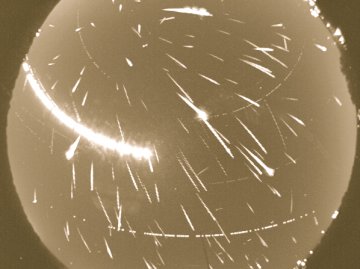
NASA astronomers Danielle Moser and Bill
Cooke made the composite of 130+ Perseids that
flew over the Marshall Space Flight Center on
August 12th. "We recorded a bright meteor or
fireball every 3 minutes--a fabulous rate,"
says Cooke. Their meteor detection system
consists of two cameras separated by 100
miles--one in Alabama and one in Georgia. The
wide baseline allows Cooke and his team to
triangulate the trajectory of meteoroids with
some accuracy.
Here is a geographic map of the Perseids
they saw. "The stars really did fall on
Alabama!" he says.
Worldwide, observers
counted as many as 200 Perseids per hour.
Some of the prettiest may be found in the
photo gallery.
UPDATED:
2009 Perseid Photo Gallery
[Science@NASA:
The Perseids are Coming,
Horse Flies and Meteors]
PERFECT NIGHT:
Robert Postma of Fort Simpson, Canada, went
outside on August 12th to see the Perseids and
got more than he bargained for. "I was treated
to a triple whammy," he says. "The auroras
came out, noctilucent clouds lit up the
horizon, and a meteor streaked across the sky.
It was a perfect night."
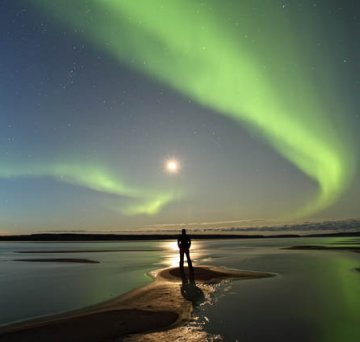
And an unlikely one....
The Perseids and, to a lesser degree, the
noctilucent clouds were expected. But where
did the auroras come from? There was no solar
flare or gust of solar wind to spark the
display. It appears to have been an unprovoked
spasm of geomagnetic activity, which appeared
on its own schedule, in the middle of the best
meteor shower in years.
Sometimes it just pays to be outside. Keep
looking up!
|
8-13-09 - No sunspots today
Current conditions
Solar wind
speed: 352.4 km/sec
density: 6.2 protons/cm3
explanation |
more data
Updated: Today at 1255 UT
X-ray Solar Flares
6-hr max: A0 1255 UT
Aug13
24-hr: A0 0605 UT
Aug13
explanation |
more data
Updated: Today at: 1255 UT
PLANET HUNTERS from the UK have discovered the largest EXOPLANET yet,
and its uniqueness doesn't end there. Dubbed WASP-17, this extra large
world is twice the size of Jupiter but is super-lightweight, "as dense
as expanded polystyrene" one astronomer said. Plus it is going the WRONG
WAY around its home sun, making it the first exoplanet known to have a
retrograde orbit. As a likely a victim of planetary billiards, astronomers
say this unusual planet casts new light on how planetary systems form and
evolve.
ASTRONOMERS SAY the planet must have flipped direction after a near miss
with another huge "big brother" planet swung it around like a slingshot.
Astronomers have long wondered why some EXTRASOLAR PLANETS are far bigger
than expected, and WASP-17 points to the explanation. Scattered into a
highly
elliptical, retrograde orbit, it would have been subjected to intense
tides.
Tidal compression and stretching would have heated the gas-giant planet to
its current, hugely bloated extent. -- Written by Nancy Atkinson
WASP-17b: an ultra-low density
planet in a probable retrograde orbit
Authors:
D. R. Anderson,
C. Hellier,
M. Gillon,
A. H. M. J. Triaud,
B. Smalley,
L. Hebb,
A. Collier Cameron,
P. F. L. Maxted,
D. Queloz,
R. G. West,
S. J. Bentley,
B. Enoch,
K. Horne,
T. A. Lister,
M. Mayor,
N. R. Parley,
F. Pepe,
D. Pollacco,
D. Ségransan,
S. Udry,
D. M. Wilson
(Submitted on 11 Aug 2009)
Abstract: We report the discovery
of the transiting giant planet WASP-17b, the least-dense planet
currently known. It is 1.6 Saturn masses but 1.5-2 Jupiter radii,
giving a density of 6-14 per cent that of Jupiter. WASP-17b is in
a 3.7-day orbit around a sub-solar metallicity, V = 11.6, F6 star.
Preliminary detection of the Rossiter-McLaughlin effect suggests
that WASP-17b is in a retrograde orbit (lambda ~ -150 deg),
indicative of a violent history involving planet-planet or
planet-star scattering.
WASP-17b's bloated radius could be due to tidal heating resulting
from recent or ongoing tidal circularisation of an eccentric
orbit, such as the highly eccentric orbits that typically result
from scattering interactions. It will thus be important to
determine more precisely the current orbital eccentricity by
further high-precision radial velocity measurements or by timing
the secondary eclipse, both to reduce the uncertainty on the
planet's radius and to test tidal-heating models. Owing to its low
surface gravity, WASP-17b's atmosphere has the largest scale
height of any known planet, making it a good target for
transmission spectroscopy.
|
8-12-09
Current conditions
Solar wind
speed: 356.2 km/sec
density: 5.5 protons/cm3
explanation |
more data
Updated: Today at 0727 UT
X-ray Solar Flares
6-hr max: A0 0720 UT
Aug12
24-hr: A0 0720 UT
Aug12
explanation |
more data
Updated: Today at: 0720 UT
POSSIBLE PERSEID METEOR OUTBURST: This year's
Perseid meteor shower could be even better than usual. According to
NASA's Meteoroid Environment Office, a filament of comet dust has drifted
across Earth's path and when Earth passes through it, sometime between
0800 and 0900 UT (1 - 2 am PDT) on August 12th, the Perseid meteor rate
could surge to twice its normal value.
POSSIBLE
PERSEID OUTBURST: This year's
Perseid meteor shower could be even better than usual. "A
filament of comet dust has drifted across Earth's path and
when Earth passes through it, sometime between 0800 and
0900 UT (1 - 2 am PDT) on August 12th, the Perseid meteor
rate could surge to twice its normal value," says Bill
Cooke of NASA's Meteoroid Environment Office. The
following profile is based on the debris stream models of
veteran forecasters Jeremie Vaubaillon and Mikhail Maslov:
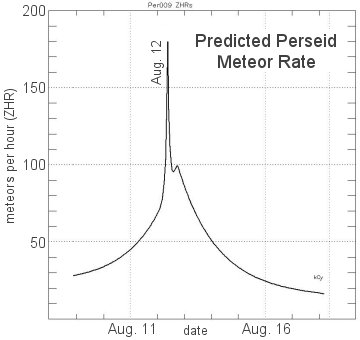
The filament was shed by Perseid parent
comet Swift-Tuttle in the year 1610, and this is one of
Earth's first encounters with it. "In addition," notes
Cooke, "the main Perseid debris stream, which we run into
every year, may be denser than normal due to a
gravitational enhancement by Saturn. The total combination
of these effects could result in as many as 200 meteors
per hour (ZHR)."
Bright moonlight will overwhelm the
outburst's fainter Perseids, but even a fraction of 200 is
a good show. Science@NASA's "The
Perseids are Coming" offers observing tips and sky
maps.

BARCELONA, SPAIN
- by Pepe Manteca
PERSEIDS NOW!
The Perseid meteor shower is about to peak. The
show begins after sunset on Tuesday, August 11th, and continues
until dawn on Wednesday, August 12th. During the long night, sky
watchers could see dozens of meteors per hour.
are seeing some bright ones," he says.
A time of
particular interest is 0800 UT (1 am PDT) on August 12th.
That's when Earth is expected to pass through a
denser-than-usual filament of dust from the shower's
parent Comet Swift-Tuttle. For an hour or so, rates could
surge to 200 per hour. Bright moonlight will blot out many
of those Perseids, but even a fraction of 200 is a good
show. Observing tips may be found in the Science@NASA
story "The
Perseids are Coming."
UPDATED:
2009 Perseid Photo Gallery
[Previous Perseids:
2008,
2007,
2006,
2005,
2004,
2001]
|
8-11-09 No sunspots today
Current conditions
Solar wind
speed: 349.3 km/sec
density: 6.5 protons/cm3
explanation |
more
data
Updated: Today at
2346 UT
X-ray Solar Flares
6-hr max: A0
2340 UT Aug11
24-hr: A0
2340 UT Aug11
explanation |
more
data
Updated: Today at:
2340 UT
|
8-10-09 - No sunspots today
Current conditions
Solar wind
speed: 391.1 km/sec
density: 3.7 protons/cm3
explanation |
more
data
Updated: Today at
0646 UT
X-ray Solar Flares
6-hr max: A0
0640 UT Aug10
24-hr: A0
0640 UT Aug10
explanation |
more
data
Updated: Today at:
0640 UT
TOP SECRET:
Not every light that streaks across the night sky is a Perseid.
Some of them are spy satellites. Here's one gliding over
Maghaberry, Northern Ireland, on August 10th:
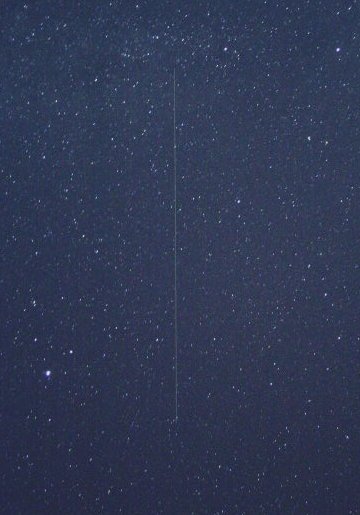
"It was Lacrosse 3," reports photographer John McConnell.
"Spaceweather's
Simple Satellite Tracker predicted a flyby and there it was."
Lacrosse 3 is a top-secret yet easily observed US National
Reconnaissance Office spy satellite. It often attracts attention
when sunlight glints brightly from its solar panels, rumored to
span 45 meters from tip to tip. The solar arrays power a synthetic
aperture radar, which can image Earth's surface with
meter-resolution even through clouds. Some web sites claim that
the radar can also sense objects underground, but that's just
speculation.
"I couldn't mistake Lacrosse 3 because it was so bright," says
McConnell. "This is even better than Perseids!"
|
8-9-09 - No sunspots today
Solar wind
speed: 396.6 km/sec
density: 3.6 protons/cm3
explanation |
more
data
Updated: Today at
2346 UT
X-ray Solar Flares
6-hr max: A0
2345 UT Aug09
24-hr: A0
2345 UT Aug09
explanation |
more
data
Updated: Today at:
2345 UT
PERSEID FIREBALL: "Last
night I photographed
17 Perseids," reports John Chumack of
Dayton, Ohio. "The best one was a fireball of
magnitude -8, about 40 times brighter than
Venus. It had a double explosion, too!"

"The Perseid meteor shower is
definitely underway," he says.
It should get even better in
the nights ahead. Members of
the International Meteor
Organization are now counting
more than 25 Perseids per
hour:
data. The rate is expected
to increase almost 10-fold on
the night of August 11th and
12th when Earth passes through
a denser-than-usual filament
of comet dust crossing Earth's
orbit. Oberving tips may be
found in the Science@NASA
story "The
Perseids are Coming."
|
8-8-09 - No sunspots today
Current conditions
Solar wind
speed: 441.9 km/sec
density: 7.5 protons/cm3
explanation |
more
data
Updated: Today at
2346 UT
X-ray Solar Flares
6-hr max: A0
2340 UT Aug08
24-hr: A0
2340 UT Aug08
explanation |
more
data
Updated: Today at:
2340 UT

Earth is inside a solar wind
stream flowing from the indicated
coronal hole.
Credit: STEREO-A Extreme UV Telescope
PERSEID UPDATE: The
Perseid meteor rate is holding steady at 20
per hour, according to observers from the
International Meteor Organization:
data. Most of these meteors are difficult
to see, however, because bright moonlight is
blotting them out. The situation should
improve on peak night, August 11th and 12th,
when as many as 200 meteors per hour are
expected to dash through waning moonlight. Get
the
full story from
Science@NASA.
RADIO
PERSEIDS:
Awash in moonlight, the
Perseid meteor shower is at
present not very easy to see.
Some observers have given up
on looking, choosing instead
to monitor the shower by means
of radio. This plot from Dave
Swan shows how he is counting
more than 300 Perseid radio
echoes per hour using a Yagi
antenna and 55.25 MHz receiver
in Bransgore, UK:
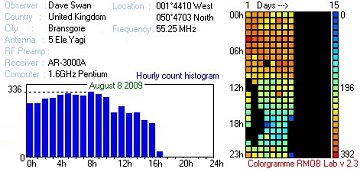
In the loudspeaker, each
echo sounds like a little
"ping." It is the reflection
of a distant TV transmitter
from the meteor's ionized
trail. Forward scatter meteor
detection, as this technique
is called, is more sensitive
than ordinary visual
observation. Very small
meteoroids are able to create
a radio echo without leaving
any trace of optical light in
the sky. That's why Swan is
counting 300 radio Perseids
per hour while naked-eye
observers are couting no more
than about 20.
Click here to monitor
forward scatter stations
around the world.
|
8-7-09 - No sunspots today
Current conditions
Solar wind
speed: 472.8 km/sec
density: 4.3 protons/cm3
explanation |
more
data
Updated: Today at
2346 UT
X-ray Solar Flares
6-hr max: ff0000">
INTENSIFYING PERSEIDS:
The Perseid meteor rate is increasing as Earth
plunges deeper into the debris stream of Comet
Swift-Tuttle. International Meteor
Organization observers are now counting 20 per
hour:
data. Forecasters say the rate could
increase another tenfold to 200 per hour on
peak night, Aug. 11th and 12th. Observing tips
may be found in the Science@NASA story "The
Perseids are Coming."
HOW HIGH IS A
PERSEID? Perseid
meteors seem so nearby when they fly overhead,
but appearances can be deceiving. Consider the
following fireball, which lit up the sky above
the Marshall Space Flight Center two nights
ago:

NASA astronomer Bill Cooke photographed the
Perseid using not one but two all-sky cameras
located 100 miles apart. The system's wide
baseline, which crosses state lines between
Alabama and Georgia, allowed him to
triangulate the meteor's position and measure
its velocity. "It came in at 58.8 km/s
(130,000 mph) and disintegrated between 111
and 86 km above Earth's surface," he says.
So far, the dual-camera system has captured
seven bright Perseids suitable for analysis.
Cooke's histograms of
starting and
ending heights answer the question,
how high is a Perseid?
|
8-6-09 - No sunspots today
Current conditions
Solar wind
speed: 504.9 km/sec
density: 3.1 protons/cm3
explanation |
more
data
Updated: Today at
2344 UT
X-ray Solar Flares
6-hr max: A0
2340 UT Aug06
24-hr: A0
2340 UT Aug06
explanation |
more
data
Updated: Today at:
2340 UT
METEOR UPDATE:
Perseid meteors are now hitting Earth's upper
atmosphere with a speed of 58 to 60 km/s,
about 130,000 mph. That's the result of
triangulation by a dual-station meteor
monitoring system operated by NASA's Meteoroid
Environment Office. Last night the system
detected five fireballs that provided the data
for this speed estimate.
EARLY PERSEIDS:
The Perseid meteor
shower is slowly intensifying as Earth plunges
deeper in Comet Swift-Tuttle's debris stream.
On August 4th, amateur astronomer Thomas
Ashcraft caught an early arrival using an
all-sky camera at his observatory near Santa
Fe, New Mexico. Click on the image to play a
movie with sound effects:
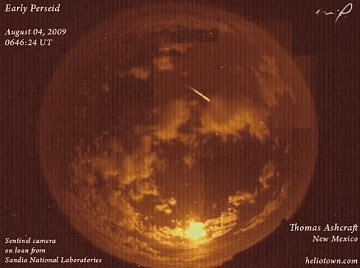
The "ping" you just heard was
a 61.25 MHz TV signal bouncing off the
meteor's ionized tail. Ashcraft keeps an
antenna trained on the sky so that he can
record the echos and lay them down as
soundtracks for his all-sky movies. "I'm sure
I'll record many more in the days ahead," he
says. "Highlights will be posted
here."
According to the International
Meteor Organization, about 10 Perseids per
hour are now streaking across the night sky:
data. This number could increase to as
many as 200 per hour when Earth crosses an
anticipated filament of comet dust around 0800
UT (1 a.m. PDT) on August 12th. Observing tips
and a sky map may be found in the Science@NASA
story "The
Perseids are Coming."
2009 Perseid Meteor Gallery
[previous Perseids:
2008,
2007,
2006,
2005,
2004,
2001]
|
8-5-09 - No sunspots today
Current conditions
Solar wind
speed: 380.0 km/sec
density: 16.2 protons/cm3
explanation |
more
data
Updated: Today at
2346 UT
X-ray Solar Flares
6-hr max: A0
2340 UT Aug05
24-hr: A0
1350 UT Aug05
explanation |
more
data
Updated: Today at:
2340 UT
|
8-4-09 - No sunspots today - 24 days without a spot
Solar wind
speed: 332.2 km/sec
density: 4.3 protons/cm3
explanation |
more data
Updated: Today at 1647 UT
X-ray Solar Flares
6-hr max: A0 1645 UT
Aug04
24-hr: A0 1645 UT
Aug04
explanation |
more data
Updated: Today at: 1645 UT
SWIRLING DEBRIS
ON JUPITER: The "Wesley impact cloud"
on Jupiter continues to expand and evolve. On August 1st and
2nd, worldwide observers noted that it had transformed from a
concentrated, cindery-black spot to an Earth-sized paling
swirl. South is up in this just-updated Aug.
3rd image from the cloud's discoverer, Anthony Wesley of
Murrumbateman, Australia:
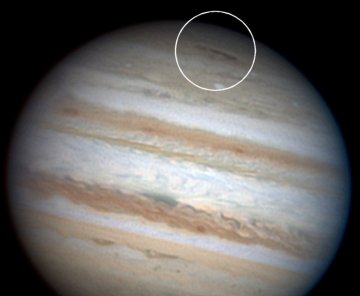
"Polar winds seem to be carrying the main body
of the cloud westward (to the right in the photo)," says
Wesley. "Also, a small stream of dark material is being pulled
down and in the opposite direction--perhaps around a cyclone
or some other localized weather feature?"
Researchers are scrambling to study the cloud
before it disperses. Light reflected from the debris may hold
clues to the nature of the
mystery-impactor. "If the cloud's spectra contain signs of
water, that would suggest an icy comet. Otherwise, it's
probably a rocky or metallic asteroid," says JPL planetary
scientist Glenn Orton. Several teams of professional
astronomers are working to obtain the data.
Meanwhile, amateur astronomers can monitor the cloud as it
shifts and swirls near Jupiter's System II longitude 210°. For
the predicted times when it will cross the planet's central
meridian, add 2 hours and 6 minutes to Sky and Telescope's
predicted transit times for Jupiter's Great Red Spot. [sky
map]
more images:
from Raffaello Lena of Rome, Italy;
from Glenn Jolly of Gilbert, Arizona, USA;
from Wah! of Hong Kong;
from William Rison of Newburg, Maryland;
from Joel Warren of Amarillo, Texas;
from David Kolb of Lawrence, Kansas;
from Alphajuno of League City, Texas;
from Mariano Ribas of Buenos Aires, Argentina;
from Giancarlo Ubaldo Nappi of Belo Horizonte, Minas
Gerais, Brazil

A solar wind stream flowing
from the
indicated coronal hole
could reach Earth on or about
Aug. 7th.
Credit:
SOHO Extreme UV Telescope
|
8-3-09 - No sunspots today
Current conditions
Solar wind
speed: 381.7 km/sec
density: 7.4 protons/cm3
explanation |
more
data
Updated: Today at
2346 UT
X-ray Solar Flares
6-hr max: A0
2340 UT Aug03
24-hr: A0
0020 UT Aug03
explanation |
more
data
Updated: Today at:
2340 UT
Jupiter Blots Out a Star
This might just be the busiest time in living memory
for people who love to observe Jupiter. First the
plane of its moons pointed edge-on to Earth,
allowing remarkable "mutual events" when the moons
eclipse and occult each other.
Then, on July 19th, Australian amateur astronomer
Anthony Wesley discovered that
a comet or asteroid had struck the giant planet,
leaving a dark marking that's still clearly visible.
This is just the second time in the 400-year history
of telescopic observing that such an event has been
clearly documented.
And on the night of August 3-4, Jupiter will cover a
6th-magnitude star — a once-in-a-lifetime occurrence
for most locations on Earth. The event occurs
roughly from 22:53 Universal Time on August 3rd to
1:00 UT August 4th, varying slightly depending on
your location. It happens at prime time for
stargazers in Europe and Africa, and is also readily
visible in the Middle East and Brazil.

S&T illustration
-->In North America, the occultation can only be seen from New
England and the Maritime Provinces — and barely so.
In those locations, Jupiter will rise while it's
hiding 45 Cap, and will still be extremely low in
the sky when the star reappears.
But by amazing good luck, 45 Cap will be
masquerading as a fifth moon during a particularly
eventful period for Jupiter's Galilean moons. So
weather permitting, every telescope owner on Earth
will have a chance to see many fascinating events
during the days before and after the occultation.
All of these events should be visible through small
telescopes if the atmosphere is very steady, but
extra aperture and high magnification will improve
the views greatly. Try our
Javascript utility or our
PDF table for details of the moons' interactions
with Jupiter. And
download a PDF article from the
July 2009 issue of Sky & Telescope to see the
details of the "mutual events" between the moons.
Aug. 1-2, 10:19 p.m. to 1:48 a.m. PDT, 1:19 to
4:48 a.m. EDT: The first sequence is visible
across the Americas. It starts with just three moons
visible (not counting 45 Cap), because Ganymede is
behind Jupiter. During this period Europa and its
shadow pass over Jupiter, Ganymede reappears, and Io
disappers.
Aug. 2-3, 9:49 p.m. to 12:25 a.m. PDT, 12:49 to
3:25 a.m. EDT: Again visible across the
Americas, a normal transit of Io and its shadow
across Jupiter — fairly common but spectacular
nonetheless.
Aug. 2, 15:55 to 16:32 UT: Best in eastern
Asia and Australia. Io casts its shadow on Europa
from 15:55 to 16:02 UT, dimming it 50%. Then Io
passes in front of Europa from 16:26 to 16:36 UT,
blocking 74% of its surface. Meanwhile, 45 Cap is
just 30" to their south.
Aug. 3-4, 22:53 to 4:39 UT, Jupiter rise to 12:39
a.m. EDT: This is the big event. The occultation
of 45 Cap is best observed from Europe and Africa,
but as you can see in the diagram above, Europa
disappears into Jupiter's shadow while the star is
hidden, and Io disappears shortly after the star
reappears. By 4:39 UT (12:39 a.m. EDT or 9:39 PDT),
all three have reappeared from behind Jupiter, but
they're still spectacularly close to Jupiter and
each other.
Aug. 4, 21:47 to 22:57 UT: In most of Europe
and Africa, and much of Asia, Ganymede casts its
shadow on Europa, diminishing its light 94%, from
21:47 to 21:59 UT. Then Ganymede clips the edge of
Europa from 22:48 to 22:57 UT.
Aug. 4-5, 23:18 to 1:51 UT: In Europe and
Africa, a normal transit of Io and its shadow.
Aug. 5, 14:38 to 23:05 UT: A very long
sequence of events, best viewed in the Middle East
and eastern Africa, but with parts visible across
Eurasia and Oceania. A transit of Ganymede and its
shadow overlapping a transit of Europa and its
shadow, with Io disappearing and reappearing toward
the end of the sequence.
Posted by Tony Flanders, July 30, 2009
|
8-2-09 - No sunspots today
Current conditions
Solar wind
speed: 370.8 km/sec
density: 13.6 protons/cm3
explanation |
more
data
Updated: Today at
2346 UT
X-ray Solar Flares
6-hr max: A0
2340 UT Aug02
24-hr: A0
2340 UT Aug02
explanation |
more
data
Updated: Today at:
2340 UT
LONELY PROMINENCE:
Yesterday,
Alan
Friedman of Buffalo, New York, looked
through his solar telescope and actually felt
sorry for the sun. "Seeing this solitary
prominence, I imagined the sun experiencing a
twinge of melancholia ... or perhaps it's my
reaction to the seemingly endless solar
minimum."
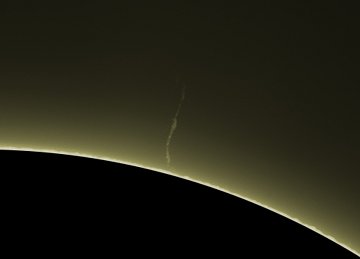
When Friedman took the picture on August
1st, the sun had just entered its 22nd
consecutive day of spotlessness--no sunspots
for more than three weeks! This is typical of
2009. So far this year, the sun has been blank
77% of the time, confirming the solar minimum
of 2008-2009 as a century-class event.
But endless? No.
Solar jet streams are beginning to
stimulate new-cycle sunspot production--e.g.,
sunspot 1024 in early July. NOAA
forecasters expect solar activity to intensify
in late 2009-early 2010 leading to a new solar
maximum in 2012-2013. If they're correct,
soon, the lonely prominence will be a thing of
the past.
|
8-1-09 - No sunspots today
Current conditions
Solar wind
speed: 385.4 km/sec
density: 4.7 protons/cm3
explanation |
more
data
Updated: Today at
2346 UT
X-ray Solar Flares
6-hr max: A0
2340 UT Aug01
24-hr: A2
0240 UT Aug01
explanation |
more
data
Updated: Today at:
2340 UT
TOP SECRET: The US
National Reconnaisance Office won't confirm
that it exists, but last night in Switzerland,
astrophotographer
Olivier
Staiger saw it with his own eyes--the
Lacrosse 3 spy satellite:

"As I saw the satellite fly across the
sky," says Staiger, "I clearly got the
impression that it became quite bright, that
it flared, akin to an Iridium flare, so I was
curious to see if the flare would show on the
photo--and yes it does."
The flare was probably sunlight glinting
from the satellite's solar panels, rumored to
span 45 meters from tip to tip. The solar
arrays are thought to power a synthetic
aperture radar, which can image Earth's
surface with meter-resolution even through
clouds. Some web sites claim that the radar
can also sense objects underground, but that's
just speculation.
You can see this top-secret satellite for
yourself--and maybe catch a flare as it soars
overhead. Check the
Simple Satellite Tracker for flyby times.
SPACE DATABASE ON THIS SITE
DREAMS OF THE GREAT EARTHCHANGES -
MAIN INDEX
|



































